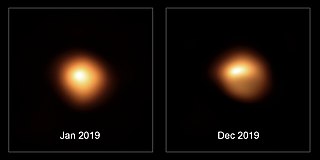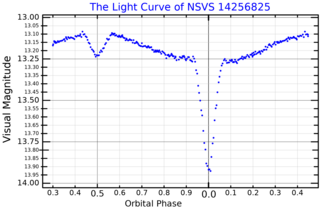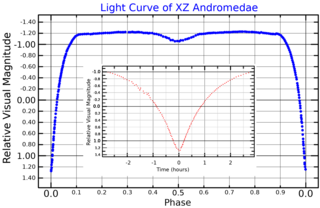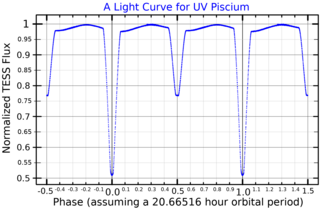Related Research Articles

Algol, designated Beta Persei, known colloquially as the Demon Star, is a bright multiple star in the constellation of Perseus and one of the first non-nova variable stars to be discovered.

A binary star or binary star system is a system of two stars that are gravitationally bound to and in orbit around each other. Binary stars in the night sky that are seen as a single object to the naked eye are often resolved using a telescope as separate stars, in which case they are called visual binaries. Many visual binaries have long orbital periods of several centuries or millennia and therefore have orbits which are uncertain or poorly known. They may also be detected by indirect techniques, such as spectroscopy or astrometry. If a binary star happens to orbit in a plane along our line of sight, its components will eclipse and transit each other; these pairs are called eclipsing binaries, or, together with other binaries that change brightness as they orbit, photometric binaries.

A variable star is a star whose brightness as seen from Earth changes with time. This variation may be caused by a change in emitted light or by something partly blocking the light, so variable stars are classified as either:
Starspots are stellar phenomena, so-named by analogy with sunspots. Spots as small as sunspots have not been detected on other stars, as they would cause undetectably small fluctuations in brightness. The commonly observed starspots are in general much larger than those on the Sun: up to about 30% of the stellar surface may be covered, corresponding to starspots 100 times larger than those on the Sun.

An RS Canum Venaticorum variable is a type of variable star. The variable type consists of close binary stars having active chromospheres which can cause large stellar spots. These spots are believed to cause variations in their observed luminosity. Systems can exhibit variations on timescales of years due to variation in the spot surface coverage fraction, as well as periodic variations which are, in general, close to the orbital period of the binary system. Some systems exhibit variations in luminosity due to their being eclipsing binaries. Typical brightness fluctuation is around 0.2 magnitudes. They take their name from the star RS Canum Venaticorum.

Algol variables or Algol-type binaries are a class of eclipsing binary stars that are similar to the prototype member of this class, β Persei. An Algol binary is a system where both stars are near-spherical such that the timing of the start and end of the eclipses is well-defined. The primary is generally a main sequence star well within its Roche lobe. The secondary may also be a main sequence star, referred to as a detached binary or it may an evolved star filling its Roche lobe, referred to as a semidetached binary.

QS Virginis is an eclipsing binary system approximately 163 light-years away from the Sun, forming a cataclysmic variable. The system comprises an eclipsing white dwarf and red dwarf that orbit each other every 3.37 hours.

NSVS 14256825, also known as V1828 Aquilae, is an eclipsing binary system in the constellation of Aquila. The system comprises a subdwarf OB star and red dwarf star. The two stars orbit each other every 2.648976 hours. Based on the stellar parallax of the system, observed by Gaia, the system is located approximately 2,700 light-years away.

XZ Andromedae is a binary star in the constellation Andromeda. Its maximum apparent visual magnitude is 9.91, but drops down to 12.45 every 1.357 days. Its variability matches the behaviour of Algol variable stars.

AB Andromedae is a binary star in the constellation Andromeda. Paul Guthnick and Richard Prager discovered that the star is an eclipsing binary in 1927. Its maximum apparent visual magnitude is 9.49 but shows a variation in brightness down to a magnitude of 10.46 in a periodic cycle of roughly 8 hours. The observed variability is typical of W Ursae Majoris variable stars, so the two stars in this system form a contact binary.

RS Canum Venaticorum is a binary star system in the northern constellation of Canes Venatici. It serves as the prototype to the class of RS Canum Venaticorum variables. The peak apparent visual magnitude of this system is below the level needed to observe it with the naked eye. It is located at a distance of approximately 443 light years from the Sun based on parallax, but is drifting closer with a net radial velocity of −14 km/s. Olin J. Eggen (1991) included this system as a member of the IC 2391 supercluster, but it was later excluded.

AO Serpentis is an eclipsing binary star system in the Serpens Caput segment of the Serpens constellation. It is invisible to the naked eye with a typical apparent visual magnitude of 11.04. Variable star observers record a peak magnitude of 10.7, dropping to 12.0 during the primary eclipse and 10.8 from the secondary eclipse. The distance to this system is approximately 1,450 light years based on parallax measurements.

TX Ursae Majoris is an eclipsing binary star system in the northern circumpolar constellation of Ursa Major. With a combined apparent visual magnitude of 6.97, the system is too faint to be readily viewed with the naked eye. The pair orbit each other with a period of 3.063 days in a circular orbit, with their orbital plane aligned close to the line of sight from the Earth. During the primary eclipse, the net brightness decreases by 1.74 magnitudes, while the secondary eclipse results in a drop of just 0.07 magnitude. TX UMa is located at a distance of approximately 780 light years from the Sun based on parallax measurements, but is drifting closer with a mean radial velocity of −13 km/s.

SZ Piscium is a suspected triple star system in the equatorial constellation of Pisces. The inner pair form a double-lined spectroscopic binary with an orbital period of 3.966 days. It is a detached Algol-type eclipsing binary of the RS Canum Venaticorum class with a subgiant component. The system is too faint to be readily visible to the naked eye with a combined apparent visual magnitude of 7.18. It is located at a distance of approximately 306 light years based on parallax measurements.

V471 Tauri is an eclipsing variable star in the constellation of Taurus. The star has a visual magnitude of 9 which makes it impossible to see with the naked eye. It is around 155 light-years away from the Solar System.

BH Virginis is a binary star system in the equatorial constellation of Virgo. With a typical apparent visual magnitude of 9.6, it is too faint to be visible to the naked eye. Based on parallax measurements, it is located at a distance of approximately 488 light years from the Sun. The system is drifting closer with a net radial velocity of −23 km/s.

UV Piscium is a binary star system in the constellation of Pisces. With a peak apparent visual magnitude of 8.98, it is too faint to be visible to the naked eye. This is an eclipsing binary system that decreases to magnitude 10.05 during the primary eclipse, then to magnitude 9.54 with the secondary eclipse. It is located at a distance of 232 light years from the Sun based on parallax measurements, and is receding with a radial velocity of 6.5 km/s. The position of this star near the ecliptic means it is subject to lunar occultation.

ER Vulpeculae is a binary star system in the northern constellation of Vulpecula, abbreviated ER Vul. It is a variable star system with a brightness that ranges from an apparent visual magnitude of 7.27 down to 7.49, which is too faint to be visible to the naked eye. This system is located at a distance of 165 light years from the Sun based on parallax measurements. It is drifting closer with a radial velocity of −25 km/s.

VV Ursae Majoris is a binary star system in the northern circumpolar constellation of Ursa Major, abbreviated VV UMa. It is a variable star system with a brightness that cycles around an apparent visual magnitude of 10.19, making it too faint to be visible to the naked eye. The system is located at a distance of approximately 1,500 light years based on parallax measurements.

RT Persei is a variable star system in the northern constellation of Perseus, abbreviated RT Per. It is an eclipsing binary system with an orbital period of 0.84940032 d (20.386 h). At peak brightness the system has an apparent visual magnitude of 10.46, which is too faint to be viewed with the naked eye. During the eclipse of the primary this decreases to magnitude 11.74, then to magnitude 10.67 with the secondary eclipse. The distance to this system is approximately 628 light years based on parallax measurements. It is drifting closer with a heliocentric radial velocity of about −12 km/s.
References
- 1 2 3 4 5 Applegate, James H. (1992). "A mechanism for orbital period modulation in close binaries". Astrophysical Journal, Part 1. 385: 621–629. Bibcode:1992ApJ...385..621A. doi: 10.1086/170967 .
- ↑ Van Buren, D. (1986). "Comment on the three-body theory for period changes in RS CVn systems". The Astronomical Journal. 92: 136–138. Bibcode:1986AJ.....92..136V. doi:10.1086/114145.
- 1 2 Hall, Douglas S. (1989). "The relation between RS CVn and Algol". Space Science Reviews. 50 (1–2): 219–233. Bibcode:1989SSRv...50..219H. doi:10.1007/BF00215932. S2CID 125947929.
- ↑ Matese, J. J.; Whitmire, D. P. (1983). "Alternate period changes in close binary systems". Astronomy and Astrophysics. 117 (2): L7–L9. Bibcode:1983A&A...117L...7M.
- ↑ Marsh, T. R.; Pringle, J. E. (1990). "Changes in the orbital periods of close binary stars". Astrophysical Journal, Part 1. 365: 677–680. Bibcode:1990ApJ...365..677M. doi:10.1086/169521.
- ↑ Maceroni, Carla (1999). "Angular Momentum Evolution in Close Late-type Binaries" (PDF). Turkish Journal of Physics . 23 (2): 289–300. Bibcode:1999TJPh...23..289M . Retrieved 24 May 2015.
- ↑ Frasca, A.; Lanza, A. F. (2005). "Orbital period variation in close binaries from radial velocity data and magnetic activity cycles". Astronomy and Astrophysics. 429: 309–316. Bibcode:2005A&A...429..309F. doi: 10.1051/0004-6361:20041007 .
- ↑ Hilditch, R. W. (2001). An Introduction to Close Binary Stars. Cambridge University Press. pp. 175–176. ISBN 978-0521798006 . Retrieved 24 May 2015.
- ↑ Watson, C. A.; Marsh, T. R. (2010). "Orbital period variations of hot Jupiters caused by the Applegate effect". Monthly Notices of the Royal Astronomical Society. 405 (3): 2037. arXiv: 1003.0340 . Bibcode:2010MNRAS.405.2037W. doi:10.1111/j.1365-2966.2010.16602.x. S2CID 111386415.
- ↑ Völschow, M.; Schleicher, D. R. G.; Perdelwitz, V.; Banerjee, R. (2016). "Eclipsing time variations in close binary systems: Planetary hypothesis vs. Applegate mechanism". Astronomy and Astrophysics . 587 (34): A34. arXiv: 1512.01960 . Bibcode:2016A&A...587A..34V. doi:10.1051/0004-6361/201527333. S2CID 53403357.
- ↑ Parsons, S. G.; Marsh, T. R.; Copperwheat, C. M.; Dhillon, V. S.; Littlefair, S. P.; Hickman, R. D. G.; Maxted, P. F. L.; Gänsicke, B. T.; Unda-Sanzana, E.; Colque, J. P.; Barraza, N.; Sánchez, N.; Monard, L. A. G. (2010). "Orbital period variations in eclipsing post-common-envelope binaries". Monthly Notices of the Royal Astronomical Society. 407 (4): 2362. arXiv: 1005.3958 . Bibcode:2010MNRAS.407.2362P. doi:10.1111/j.1365-2966.2010.17063.x. S2CID 96441672.
- ↑ Schwarz; et al. (2009). "Hunting high and low: XMM monitoring of the eclipsing polar HU Aquarii". Astronomy and Astrophysics . 496 (3): 833–840. arXiv: 0901.4902 . Bibcode:2009A&A...496..833S. doi:10.1051/0004-6361/200811485. S2CID 14243402.